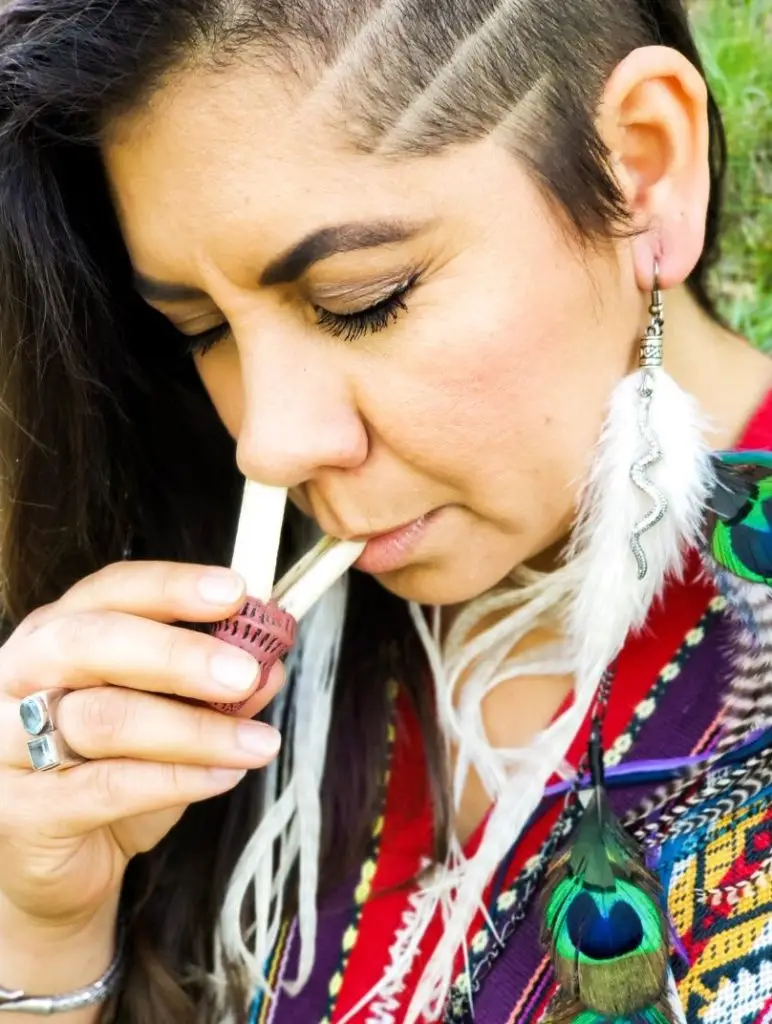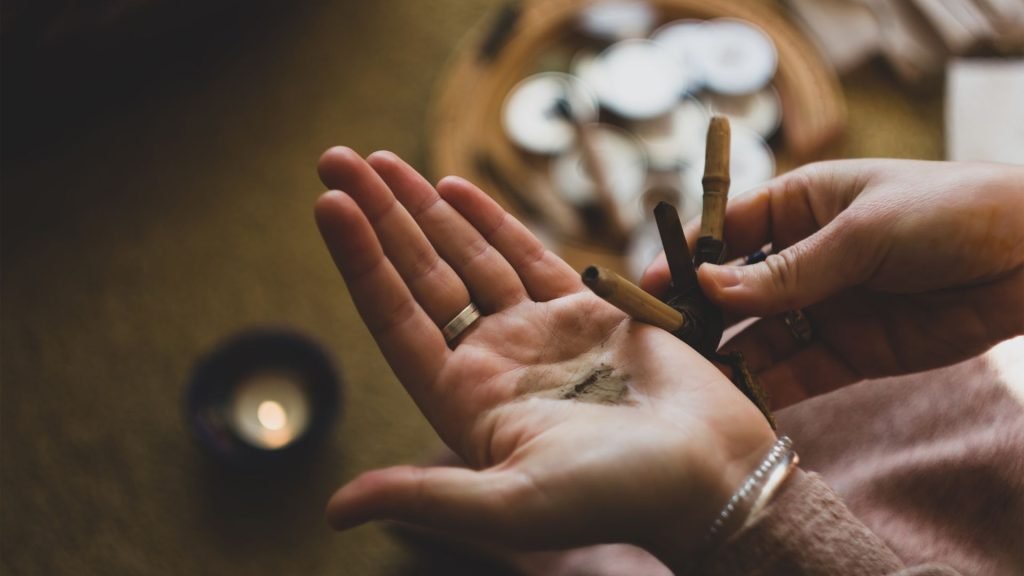

It is undeniable the wide popularity that this substance has been gaining during the last years, related to shamanic rituals and local mysticism, but what is rapé? Is it a drug? Is it addictive? Is it legal? How can it be consumed and why should it be? Within this article we will try to answer all the doubts you may have about this powerful shamanic rapé tobacco from the Amazon.
Also known by other names such as Hape, Rapeh, Hapé, rapé is visually a very fine, dry and usually greenish powder. It is most often used by the shamans of South America, who have been using it medicinally for centuries. It is mainly composed of a special type of tobacco.
Today, rapé has gained great popularity among the spiritual community in many countries. It is used as a tool that facilitates deeper meditation, and is also part of the preparation for spiritual ceremonies, such as ayahuasca and kambo. And even more and more conscious people are attending pure rapé ceremonies, in which shamanic rapé is used as a tool to elevate to a higher state of consciousness.
For as long as the ceremonial use of rapé has been known, it has traditionally been produced in South America. But the growing demand for this powder has extended production to other parts of the world. Unfortunately, it is becoming increasingly common to come across rapé powders that are sold as South American, but are actually produced elsewhere in an industrial process.
So rapé is nothing more than a kind of rapé powder? Technically, yes. Although taking it as just that makes us fall into a very reductive definition where much of the spiritual and cultural value of this substance is lost. In fact, this shamanic rapé has been produced for centuries by various South American tribes, mostly located within the countries of Peru and Brazil, through a long and tedious process, which consists of mixing tobacco with a wide range of Amazonian medicinal plants. Some indigenous communities that prepare rapé are the Katukina, Kaxinawa and Nu-nu tribes.
Each tribe has a unique recipe for the preparation of rapé and its own cultural value within their environment, this recipe is passed down from generation to generation and kept secret. This is how there can be a great variety of types of shamanic rapé, each of which has a different taste and effect.
What are the ingredients of shamanic rapé?
In a nutshell, the ingredients that make up rapé are tobacco, wood ash and medicinal herbs.
The main ingredient of rapé (also known as Hapé, Rapeh) is a special blend of tobacco called Nicotiana Rústica (also known as mapacho), which contains up to 20 times the amount of nicotine usually found in regular tobacco, and is mixed with various medicinal plants, such as mint, clover, tonka bean, banana peels and cinnamon. Local tree bark is burned to produce the ash used in its preparation.
Some rapé recipes also include more potent ingredients, such as anadenanthera, jurema and coca. You will even find a mixture of rapé with a small percentage of datura, which is a very potent psychotropic plant.
Because of the wide variety of rapés you will find, you will have effects that are sometimes very mild, sometimes very strong, and depending on the combination used in a specific tribe, the range of experiences you can have is really wide.
How to take rapé?

The pipe generally used to administer this substance in the nostril is called Tepi.
You should know that the consumption of rapé is a ceremony. Amazonian communities administer it to each other using a pipe called Tepi. They introduce a certain amount of shamanic snuff in the pipe, apply the pipe in the nostril of the other person and blow the snuff in the nose.
An alternative way to take the shamanic rapé is to use the Kuripe, a small V-shaped pipe that allows the mixture to be self-administered.
Always make sure that the snuff is administered by an expert you trust. In fact, the trusting relationship with the shaman is a crucial part of the experience. It allows you to focus on the experience itself, without worrying about the process.
The shaman is also responsible for choosing the amount of snuff that is administered and the force with which it is blown into the nose, as the manner and amount in which it enters your system is also of great relevance to the experience.
Rapé is often used as a fundamental part of Ayahuasca ceremonies.
Benefits of rapé tobacco
The uses that are generally given to this substance are spiritual in nature, many people find clarity when they have this practice and it can even be used to intensify the connection during tantra and tao exercises, or as preparation for more intense shamanic ceremonies such as Kambo and ayahuasca, or other ceremonies with plants.
Depending on the blend used, they can serve as a tool for increasing the body's energy, sharpening the focus of the mind, and for cleansing, releasing negative energy and grounding.
Thus, the benefits of snuff tobacco clearly depend on the composition of the rapé.
With lighter doses and blends, benefits may include a pleasant sensation in the nose, opening of the nostrils in case of a cold, and a feeling of slight detachment.
Psychedelic-based mixtures with snuff can induce much more profound effects. Therefore, it is crucial to know what kind of rapé you are going to take: you don't want to start hallucinating if that wasn't part of the plan!

Everyone reacts differently to taking shamanic rapé. The most common side effect of rapé is a runny nose. In a professional ceremony you will notice that there are always tissues ready to use.
It is good practice to blow your nose firmly after administration to blow the dust out of your nose.
On rare occasions, vomiting can be another side effect of rapé. However, it is not as common to happen.
So, is shamanic rapé a drug?
The answer really depends on the type of shamanic snuff (also known as Hapé, Rapeh) and what you personally consider a drug.
If you consider tobacco to be a drug, then shamanic rapé is also a drug. If it contains psychotropic substances, it is, in fact, a psychedelic drug.
Although you should note that if you are a fan of shamanism and believe that sacred medicine has the gift to help you reach a higher state of consciousness, then rapé is not a drug: it is, instead, a powerful facilitating tool.
In the Amazon, people use snuff for both medicinal and recreational purposes. Shamans administer it to cure people of various illnesses and to help them achieve a better state of mind.
But among the various tribes, you will also find people who consume rapé for recreational purposes.
Is rapé legal?
Most legal authorities around the world do not consider rapé an illegal or restricted-use drug.
However, because shamanic snuff tobacco can be made with different herbs, it may technically be treated as a drug when it includes substances that are not permitted by local law.
For example, if snuff contains a large amount of coca leaves, it can be treated as a drug in most countries where cocaine is illegal. But in Peru and Colombia, where possession and cultivation of coca plants are legal in certain quantities and under certain rules, it may be allowed within certain limitations.
Some people I know have also investigated how to transport snuff between countries. The limitations for transporting shamanic tobacco across borders are pretty much the same as those that apply to regular tobacco.
European legislation allows up to 1 kg of tobacco to be carried through immigration. Similar rules apply in the United States.
Is it addictive?
Yes, it is. The main ingredient in snuff is nicotiana Rustica, a type of tobacco that contains a higher level of nicotine. Nicotine is a highly addictive substance. Because of this, shamanic snuff is also addictive.
Rapé should not be consumed frequently. Taking snuff is a ceremonial activity and, as a ceremonial substance, it should be treated with awareness and above all respect.
Random Posts

How much does it cost to hike the Inca Trail?

What Reptiles Can You See on a Tour in Tambopata?

What is the best time to visit the Amazon rainforest?

Exploring Choquequirao: Beyond Machu Picchu

 Español
Español  Português
Português 
 English
English 






































